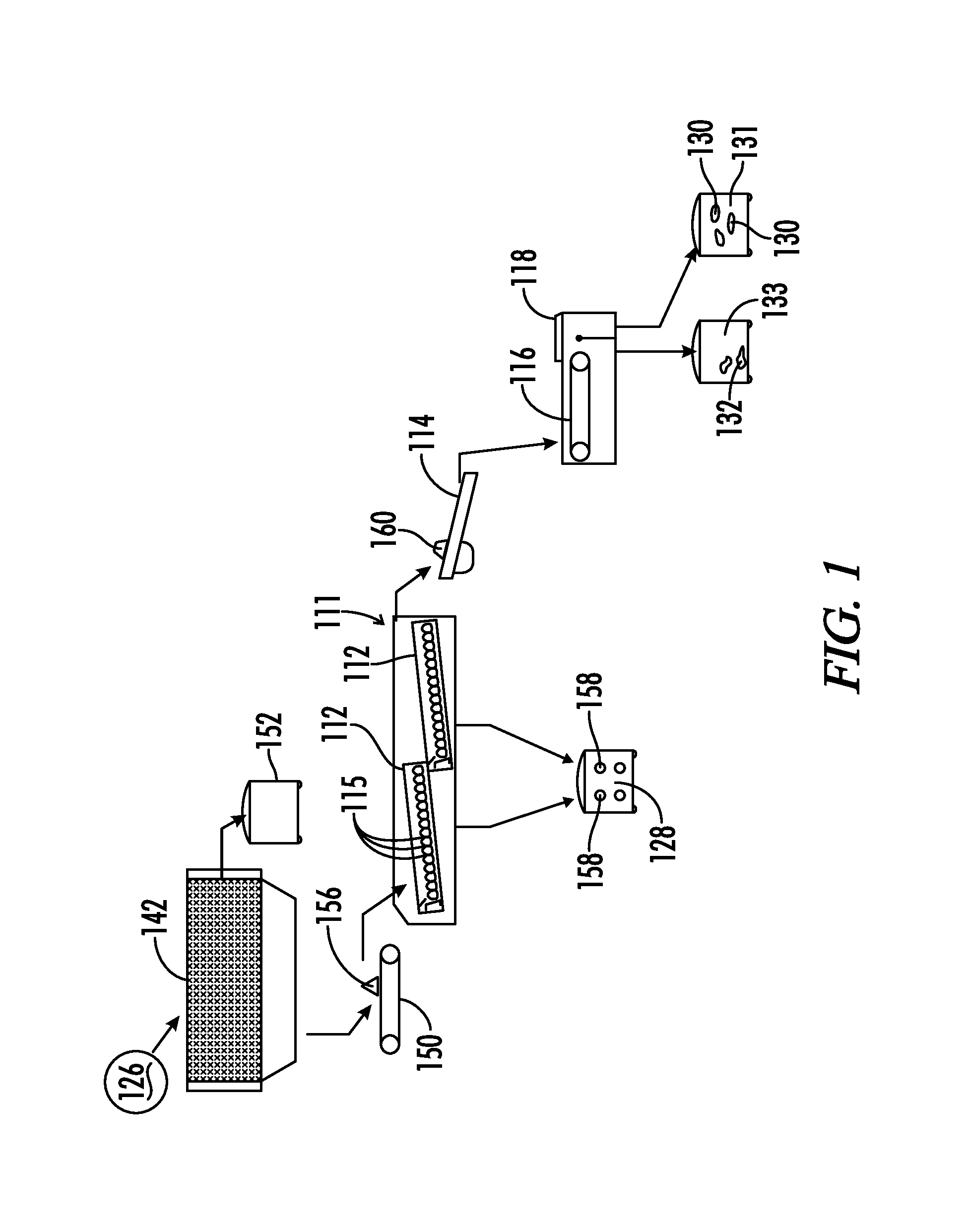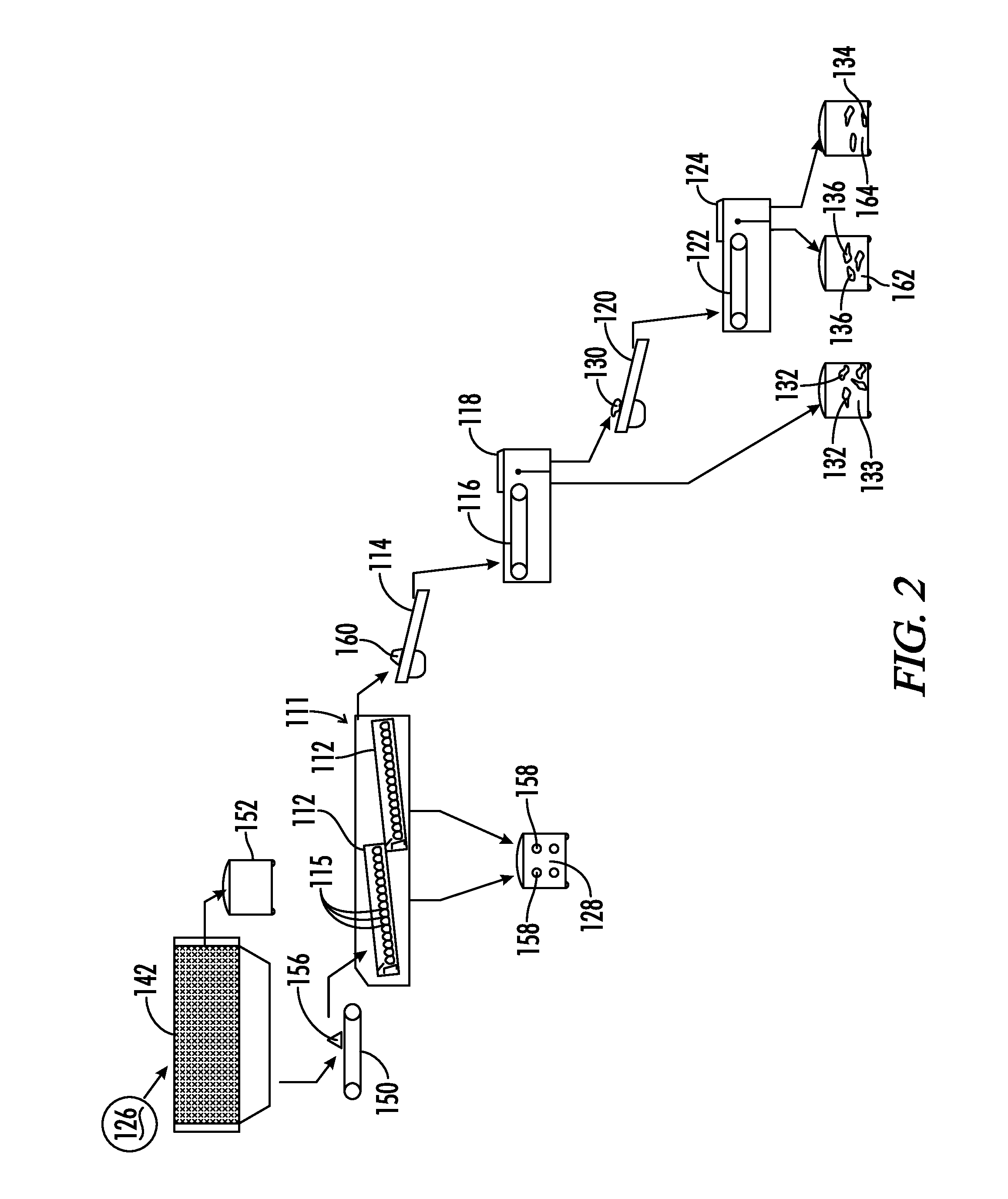Methods of Processing Waste Material to Render a Compostable Product
a technology of waste material and compostable products, applied in the direction of gas current separation, centrifuges, grain treatment, etc., can solve the problems of difficult processing of waste material in order to isolate certain materials, dry parts, and difficult problems, so as to reduce the yield of organic material available for collection, less inorganic material, and less organic material
- Summary
- Abstract
- Description
- Claims
- Application Information
AI Technical Summary
Benefits of technology
Problems solved by technology
Method used
Image
Examples
example 1
[0050]In a first embodiment of the process disclosed herein, the solid waste 126 being sorted is placed in a material sizing device 142 so that waste 126 having a size of two inches or less is then delivered to a conveyor 150 for delivery to a debris roll screen 112. The debris roll screen 112 separates out any material having a size of a one half inch or less. Such one half inch or less material is removed by placement on a residue collection conveyor. The suitable size waste material 160 having a size from about two inches to about a one half inch is delivered to a first vibrating feeder 114. The first vibrating feeder 114 helps breaks apart the waste 160 for more efficient separation. The first vibrating feeder 114 then delivers the waste 160 to a first accelerated conveyor 116 which feeds the waste 160 into the first sorting device 118 for sorting. The first sorting device 118 may be a device as described herein which is commercially available from National Recovery Technologies...
example 2
[0051]In certain embodiments of the process disclosed herein, further purification of the first organic fraction 130 is desirable. Further purification is accomplished by performing the following steps on the first organic fraction 130 from Example 1. The first organic fraction 130 is delivered to a second vibrating feeder 120 to allow fragmenting, or breaking apart of the material. The first organic fraction 130 is placed on a second accelerated conveyor 122 for delivery to a second sorting device 124. The result of the action of the second sorting device 124 is to separate the first organic fraction 130 into a second organic fraction 134 and a second inorganic fraction 136. The resulting second organic fraction 134 is a product that is available for use in composting or as otherwise described herein.
[0052]In still other embodiments of the process disclosed herein, further purification of the first inorganic fraction 132 may be desirable in order to increase the yield of organic ma...
example 3
[0053]In yet another embodiment of the present invention, the following steps result in the separation of the waste 126 into organic and inorganic fractions, with the additional separation of both of the organic and inorganic materials so that further organic material may be obtained from the inorganic material, in order to increase organic material yield. Also, the initial organic material is purified through the steps as disclosed in Example 2.
[0054]The first inorganic fraction 132 resulting from Example 1 goes through further separation. The first inorganic fraction 132 is subjected to fragmenting, or breaking apart, on a third vibrating feeder 134. The first inorganic fraction 132 is placed on a third accelerated conveyor 146 for delivery to a third sorting device 148 for sorting of it into a third organic fraction 138 and a third inorganic fraction 140. The third organic fraction 138 may be combined with the second organic fraction 134. The final organic composition is then put...
PUM
 Login to View More
Login to View More Abstract
Description
Claims
Application Information
 Login to View More
Login to View More - R&D
- Intellectual Property
- Life Sciences
- Materials
- Tech Scout
- Unparalleled Data Quality
- Higher Quality Content
- 60% Fewer Hallucinations
Browse by: Latest US Patents, China's latest patents, Technical Efficacy Thesaurus, Application Domain, Technology Topic, Popular Technical Reports.
© 2025 PatSnap. All rights reserved.Legal|Privacy policy|Modern Slavery Act Transparency Statement|Sitemap|About US| Contact US: help@patsnap.com



